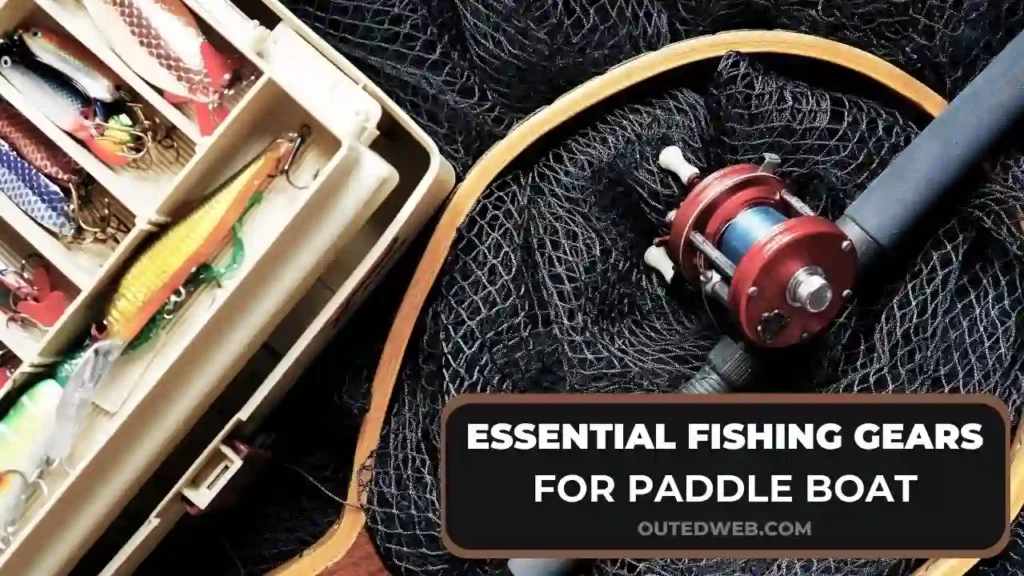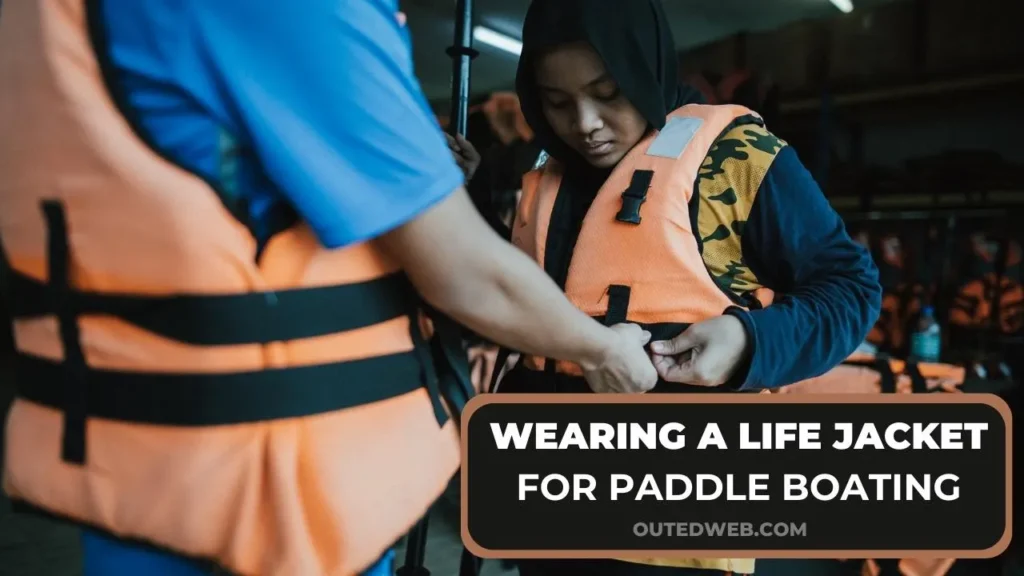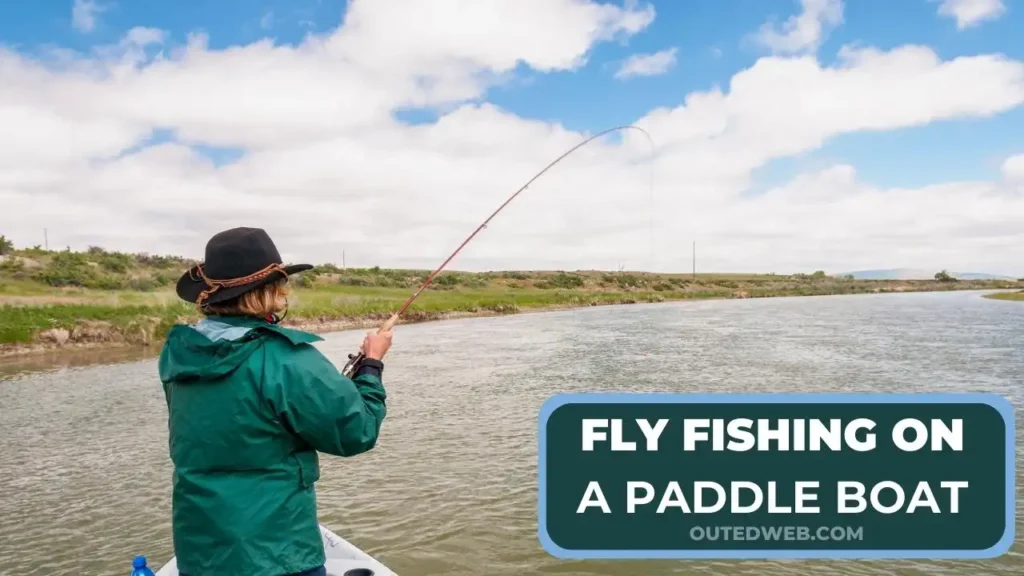Imagine yourself gliding on a tranquil lake surrounded by nature’s splendor. As you paddle leisurely, the sun warms your face, and you feel the river’s smooth flow beneath your boat. As you enjoy the peace and quiet, an idea occurs to you—can you fish from a paddle boat?
Yes! Fishing from a paddle boat, also known as a pedal boat, is possible and offers a unique and rewarding fishing experience. Whether a beginner or an experienced angler, paddle boat fishing can be an exciting way to enjoy the outdoors, exercise, and reel in your favorite freshwater fish.
In this comprehensive guide, we’ll delve into what makes paddle boats ideal for fishing, explore any considerations or limitations to be aware of, and provide valuable tips to help you get started. So, let’s embark on a journey that will unlock a world of angling possibilities from the comfort of a paddle boat.
What Makes Paddle Boats Ideal for Fishing?
Regarding fishing, paddle boats offer a range of advantages that make them an ideal choice for anglers of all levels. Let’s dive into what separates these vessels and why they are well-suited for fishing adventures.
Stability and Maneuverability:
Paddle boats are designed with stability in mind. They typically feature a wide, flat hull that provides excellent stability, even in calm waters. This stability allows anglers to cast their lines without worrying about tipping over.
Additionally, these boats offer exceptional maneuverability thanks to their pedal or paddle propulsion systems. Anglers can easily navigate tight spaces, shallow waters, and intricate fishing spots that might be off-limits to larger watercraft.
Accessibility to Fishing Spots:
One of the biggest advantages of fishing from a paddle boat is the accessibility it provides. These compact vessels can access smaller lakes, ponds, and narrow waterways that larger boats cannot reach.
This means you can explore hidden gems and fish in secluded areas that are teeming with fish. Paddle boats’ shallow draft allows them to navigate through reeds, grassy areas, and other shallow-water habitats where fish tend to congregate.
Stealth and Quiet Operation:
When it comes to fishing, silence is golden. Paddle boats excel in this aspect, as they allow anglers to glide silently through the water without the noise and disturbance caused by motorized boats.
The absence of engine noise minimizes the chances of startling fish, increasing your chances of success. This stealthy approach also allows you to observe fish behavior and spot underwater structures with ease.
Versatility and Customization:
Paddle boats offer versatility, enabling anglers to customize their fishing setup according to their preferences. Most paddle boats have spacious decks that can accommodate fishing gear, coolers, and other essentials.
Some models even come equipped with built-in rod holders, tackle storage compartments and other fishing-specific features. This adaptability allows you to personalize your paddle boat to meet your fishing needs and create a comfortable and efficient fishing platform.
Cost-Effectiveness:
Compared to larger motorized boats, paddle boats are a cost-effective option for fishing enthusiasts. They are generally more affordable to purchase or rent, and their maintenance costs are minimal.
Paddle boats don’t require fuel or expensive mechanical repairs, making them a budget-friendly choice for anglers who want to enjoy fishing without breaking the bank.
Read Related Articles:
Are There Any Considerations or Limitations?
While fishing from a paddle boat offers numerous advantages, it’s essential to be aware of certain considerations and limitations to ensure a safe and enjoyable experience. Let’s explore some key factors to keep in mind when engaging in the paddle boat fishing.
Fishing Regulations and Licensing:
Before heading out on your paddle boat fishing expedition, familiarize yourself with your area’s fishing regulations and licensing requirements.
Different regions may have specific rules regarding fishing seasons, catch limits, and the need for fishing licenses.
Ensure you have the necessary permits to fish legally and responsibly, as non-compliance can result in penalties and harm the local ecosystem.
Space and Storage:
Paddle boats, although versatile, have limited space compared to larger fishing boats.
Consider the amount of fishing gear, tackle boxes, coolers, and other equipment you plan to bring and ensure that your paddle boat can accommodate them comfortably.
Efficient storage solutions, like using waterproof bags or attaching gear holders to the boat, can help maximize space and keep your equipment organized.
Physical Exertion:
Unlike motorized boats, paddle boats require physical exertion to propel and maneuver.
Keep in mind that operating a paddle boat requires pedaling or paddling, which can be physically demanding, especially during long fishing trips or against strong currents.
Assess your fitness level and ensure you are prepared for physical activity. Take breaks as needed and listen to your body to avoid overexertion.
Fishing Gear and Equipment:
When fishing from a paddle boat, examining the type and amount of fishing gear you employ is critical. Given the limited space, opt for compact, lightweight equipment that is easy to handle and won’t obstruct your movements.
Adjustable fishing rods, collapsible fishing nets, and tackle boxes with removable compartments are examples of gear that can enhance your paddle boat fishing experience.
How to Get Started with Paddle Boat Fishing?
If you’re ready to go paddle boat fishing, here are some tips to get you started and make the most of your experience:
Choose the Right Paddle Boat:
Select a paddle boat that suits your fishing needs. Consider factors such as stability, size, weight capacity, storage options, and fishing-specific features like rod holders. Demo different models if possible to find the one that feels comfortable and meets your requirements.
Gather Essential Fishing Gear:
Assemble your fishing gear, keeping in mind the limited space on a paddle boat. Bring fishing rods, reels, lines, hooks, bait, and any other tackle you prefer. Opt for compact and lightweight equipment that won’t hinder your movements. Don’t forget essentials like a fishing license, life jacket, sunscreen, and a first aid kit.

Plan Your Fishing Location:
Research and identify suitable fishing spots for your paddle boat adventure. Look for lakes, ponds, or calm inland waterways known for their fish populations. Check local fishing reports or consult with experienced anglers to gather information about the target species, their habits, and preferred fishing techniques.
Familiarize Yourself with the Paddle Boat:
Before setting off, become acquainted with the paddle boat’s features and controls. Practice maneuvering the boat, pedaling or paddling, and turning. Familiarize yourself with the boat’s stability and learn how to maintain balance while fishing. This preparation will help you feel more confident and comfortable on the water.
Pack Strategically:
Efficiently organize your fishing gear and essentials on the paddle boat. Utilize storage compartments, attach gear holders or rod holders, and secure items to prevent accidental loss overboard. Distribute the weight evenly to maintain stability and avoid overloading the boat.
Choose the Right Fishing Technique:
Depending on your target species and the fishing location, select appropriate fishing techniques. Common techniques for paddle boat fishing include casting, trolling, and still fishing. Experiment with different lures, baits, and retrieval speeds to find what works best in your chosen fishing spot.
Practice Patience and Observation:
Fishing from a paddle boat requires patience and attentiveness. Take the time to observe the water’s surface for signs of fish activity, such as ripples, jumps, or bird diving.
Look for underwater structures like submerged logs, vegetation, or drop-offs where fish may congregate. Use polarized sunglasses to enhance your visibility beneath the water’s surface.
Safety Tips for Paddle Boat Fishing
When engaging in paddle boat fishing, it’s crucial to prioritize safety to ensure a secure and enjoyable experience on the water. Here are some essential safety precautions to remember:
Wear a Life Jacket:
Always wear a properly fitted U.S. Coast Guard-approved life jacket while on a paddle boat. Life jackets provide buoyancy and can be a lifesaver in case of an accident or unexpected circumstances. Choose a life jacket specifically designed for water sports, and ensure it fits snugly and allows for freedom of movement.

Check the Weather Forecast:
Before heading out, check the weather forecast for your fishing location. Avoid going out on the water during severe weather conditions, including storms, strong winds, or lightning. Sudden weather changes can make paddling difficult and increase the risk of accidents. Postpone your fishing trip if adverse weather is expected.
Inform Someone:
Before setting off your paddle boat fishing expedition, inform a trusted person about your plans. Provide them details such as your fishing location, estimated return time, and emergency contact information. This precaution ensures that someone knows your whereabouts and can take appropriate action.
Be Mindful of Water Conditions:
Pay attention to water conditions and factors such as water temperature, currents, and visibility. Avoid areas with strong currents or hazardous underwater obstacles. If you encounter rough or choppy water, exercise caution and stay close to the shore or in calmer areas.
Protect Yourself from the Sun:
Fishing under the sun exposes you to harmful ultraviolet (UV) rays. Apply a broad-spectrum sunscreen with a high SPF rating to all exposed skin, even on cloudy days. Use UV-protective gear such as caps, long-sleeved shirts, and sunglasses to protect yourself from the sun’s rays.
Stay Hydrated and Bring Snacks:
Fishing can be physically demanding, especially when paddling a boat. Stay hydrated by bringing an adequate supply of water or sports drinks. Pack light snacks to keep your energy levels up during the fishing trip. Remember to drink and eat regularly to avoid fatigue or dehydration.
Practice Paddle Boat Stability:
Maintaining stability on a paddle boat is crucial to prevent accidents. Distribute your weight evenly on the boat and avoid sudden movements that could lead to imbalance. Keep your center of gravity low, and be mindful of shifting your weight while casting or reeling in fish.
Be Aware of Other Watercraft:
Stay alert and be mindful of other watercraft in the area, including motorized boats, kayaks, and canoes.
Maintain a safe distance from other vessels and follow boating etiquette. Signal your intentions, such as changes in direction or stopping, using appropriate hand signals or auditory signals to communicate with others.
Practice Proper Boating Etiquette:
Respect other anglers, boaters, and wildlife while on the water. Avoid excessive noise, maintain a reasonable distance from other fishing spots, and avoid disturbing the peace of the environment. Dispose of trash responsibly and leave the area cleaner than you found it.
Develop Basic Water Skills:
Prior to paddling boat fishing, ensure you possess basic water skills, such as the ability to swim and tread water comfortably. Familiarize yourself with self-rescue techniques in case you accidentally fall into the water. Practice getting back onto the paddle boat safely from the water if needed.
Popular Fishing Techniques for Paddle Boat Fishing
You may improve your chances of success when paddle boat fishing by using a number of efficient strategies. Here are some popular fishing methods to think about:
Casting:
With the flexible technique of casting, you may cover a large region and go for a particular kind of fish.
Cast your lure or bait using spinning or baitcasting rods towards places where fish are likely to be present, such as beside structures or along the coast.
Improve your accuracy and distance by practicing various casting methods, such as sidearm or overhead casts.
Trolling:
Dragging a baited line behind your paddle boat while you move it slowly is known as trolling. Using this method, you may attract fish that are actively eating or cruising while covering bigger regions of water.
To keep a constant trolling speed, use a trolling engine or paddle at a constant speed. Try out several lures, such as spoons, crankbaits, or soft plastics, to see which ones fish in your preferred fishing location seem to be drawn to.
Still Fishing:
Casting your baited hook and letting it lie on the bottom or at a certain depth is known as still fishing, also known as bottom fishing or bait fishing.
When used to catch bottom-dwelling fish species like catfish, carp, or panfish, this method is efficient.
Maintain the depth of your bait using a slip bobber or weighted rig while keeping an eye out for nibbles or bites.
Jigging:
Jigging is a technique that involves using a jig, a weighted hook with a lure or bait attached, to create an enticing vertical motion in the water.
Drop the jig to the desired depth and then lift and drop it in a rhythmic manner to mimic the movements of injured prey.
Jigging can be particularly effective for attracting predatory fish like bass, walleye, or pike.
Fly Fishing:
If you’re an avid fly angler, you can also enjoy paddle boat fishing using fly fishing techniques. Choose a paddle boat that provides stability and sufficient casting space.

Utilize lightweight fly rods and floating or sinking fly lines depending on your target species and the water conditions. Present your fly using various techniques like dry fly fishing, nymphing, or streamer fishing to entice fish to strike.
Vertical Jigging:
When vertical jigging, a weighted lure is dropped directly into the water column, lifted vertically, and then dropped again. This method is frequently employed in regions with structure, such as deeper water or buried rocks or ledges. Bass, walleye, or lake trout can all be caught with vertical jigging.
Sight Fishing:
Paddle boats provide an advantage for sight fishing, allowing you to spot fish in clear or shallow waters. Polarized sunglasses are essential for reducing glare and enhancing your ability to see fish beneath the surface. Stand or sit on a raised platform on your paddle boat to improve your visibility and make precise casts to visible fish.
Combination Techniques:
Don’t limit yourself to just one fishing technique. Experiment with a combination of techniques based on the conditions, target species, and your personal preferences. For example, you can troll to cover larger areas and then switch to casting or jigging when you locate a concentration of fish.
Remember that the success of each approach varies based on circumstances like time of year, water conditions, and the preferences of the fish species you’re attempting to catch. Be versatile and open to exploring new ways to find out what works best for you.
Final Say
Paddle boat fishing offers a unique and enjoyable way to pursue your passion for angling. These boats are a fantastic platform for fishermen of all skill levels due to their mobility, stability, and access to various fishing situations.
Whether you prefer casting, trolling, still fishing, or more specialized techniques like jigging or fly fishing, there are plenty of options to suit your preferences and target a wide range of fish species.
However, it’s essential to consider safety precautions, adhere to fishing regulations, and be mindful of environmental conservation. Following the tips and techniques discussed in this guide can enhance your paddle boat fishing experience and increase your chances of success on the water.
So grab your paddle boat, gear up, and embark on memorable fishing adventures while enjoying the serenity and excitement of paddle boat fishing.

